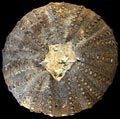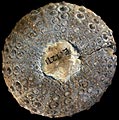The Echinoid Directory
Actinophyma Cotteau & Gauthier, 1895, p. 96
| Diagnostic Features |
|
|---|---|
| Distribution | Upper Cretaceous (Campanian-Maastrichtian); Iran and the Middle East. |
| Name gender | neuter |
| Type | Actinophyma spectabile Cotteau & Gauthier, 1895, p. 96, by original designation. |
| Species Included |
|
| Classification and/or Status |
|
| Remarks |
|





